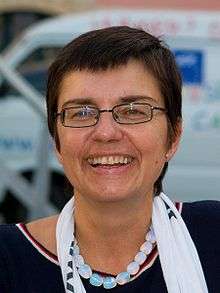1995 Austrian legislative election
Parliamentary elections were held in Austria on 17 December 1995 to elect the 20th National Council, the lower house of Austria's bicameral parliament.[2] The snap election was called after the collapse of the grand coalition between the Social Democratic Party of Austria (SPÖ) and Austrian People's Party (ÖVP) due to a dispute regarding the national budget. The SPÖ made small gains primarily at the expense of minor parties, while the ÖVP remained stable. The grand coalition was subsequently renegotiated.
| ||||||||||||||||||||||||||||||||||||||||||||||||||||||||||||||||||||||||||||||||||
All 183 seats in the National Council 92 seats needed for a majority | ||||||||||||||||||||||||||||||||||||||||||||||||||||||||||||||||||||||||||||||||||
|---|---|---|---|---|---|---|---|---|---|---|---|---|---|---|---|---|---|---|---|---|---|---|---|---|---|---|---|---|---|---|---|---|---|---|---|---|---|---|---|---|---|---|---|---|---|---|---|---|---|---|---|---|---|---|---|---|---|---|---|---|---|---|---|---|---|---|---|---|---|---|---|---|---|---|---|---|---|---|---|---|---|---|
| Turnout | 4,959,455 (86.0%)[1] | |||||||||||||||||||||||||||||||||||||||||||||||||||||||||||||||||||||||||||||||||
| ||||||||||||||||||||||||||||||||||||||||||||||||||||||||||||||||||||||||||||||||||
 Results of the election, showing seats won by state and nationwide. States are shaded according to the first-place party. | ||||||||||||||||||||||||||||||||||||||||||||||||||||||||||||||||||||||||||||||||||
| ||||||||||||||||||||||||||||||||||||||||||||||||||||||||||||||||||||||||||||||||||
Contesting parties
The table below lists parties represented in the 19th National Council.
| Name | Ideology | Leader | 1994 result | |||
|---|---|---|---|---|---|---|
| Votes (%) | Seats | |||||
| SPÖ | Social Democratic Party of Austria Sozialdemokratische Partei Österreichs |
Social democracy | .jpg) Franz Vranitzky |
34.9% | 65 / 183 | |
| ÖVP | Austrian People's Party Österreichische Volkspartei |
Christian democracy |  Wolfgang Schüssel |
27.7% | 52 / 183 | |
| FPÖ | Freedom Party of Austria Freiheitliche Partei Österreichs |
Right-wing populism Euroscepticism |
.jpg) Jörg Haider |
22.5% | 42 / 183 | |
| GRÜNE | The Greens – The Green Alternative Die Grünen – Die Grüne Alternative |
Green politics |  Madeleine Petrovic |
7.3% | 13 / 183 | |
| LiF | Liberal Forum Liberales Forum |
Liberalism | .jpg) Heide Schmidt |
6.0% | 11 / 183 | |
Results
| Party | Votes | % | +/− | Seats | +/− | ||
|---|---|---|---|---|---|---|---|
| Social Democratic Party of Austria (SPÖ) | 1,843,474 | 38.06 | +3.14 | 71 | +6 | ||
| Austrian People's Party (ÖVP) | 1,370,510 | 28.29 | +0.62 | 52 | ±0 | ||
| Freedom Party of Austria (FPÖ) | 1,060,377 | 21.89 | –0.61 | 41 | –1 | ||
| Liberal Forum (LiF) | 267,026 | 5.51 | –0.45 | 10 | –1 | ||
| The Greens – The Green Alternative (GRÜNE) | 233,208 | 4.81 | –2.50 | 9 | –4 | ||
| No – Civic Action Group against the sale of Austria (NEIN) | 53,176 | 1.10 | +0.20 | 0 | ±0 | ||
| Communist Party of Austria (KPÖ) | 13,938 | 0.29 | +0.03 | 0 | ±0 | ||
| Austrian Natural Law Party (ÖNP) | 1,634 | 0.00 | –0.01 | 0 | ±0 | ||
| The Best Party (DBP) | 830 | 0.00 | ±0.00 | 0 | ±0 | ||
| Invalid/blank votes | 115,282 | – | – | – | – | ||
| Total | 4,959,455 | 100 | – | 183 | 0 | ||
| Registered voters/turnout | 5,768,099 | 85.98 | +5.74 | – | – | ||
| Source: Austrian Interior Ministry | |||||||
Results by state
| State | SPÖ | ÖVP | FPÖ | LiF | Grüne | Others | |||
|---|---|---|---|---|---|---|---|---|---|
| 44.6 | 31.9 | 16.9 | 3.3 | 2.5 | 0.8 | ||||
| 40.8 | 18.5 | 32.7 | 3.6 | 3.5 | 0.9 | ||||
| 37.9 | 34.5 | 17.3 | 5.0 | 3.7 | 1.6 | ||||
| 38.1 | 29.5 | 21.6 | 4.4 | 5.1 | 1.3 | ||||
| 32.6 | 29.1 | 25.4 | 6.1 | 5.6 | 1.2 | ||||
| 39.7 | 29.5 | 21.2 | 4.2 | 4.0 | 1.4 | ||||
| 27.3 | 31.3 | 27.0 | 6.2 | 6.4 | 1.8 | ||||
| 22.9 | 34.1 | 27.4 | 7.1 | 7.3 | 1.2 | ||||
| 44.0 | 19.5 | 20.1 | 8.6 | 6.0 | 1.8 | ||||
| 38.1 | 28.3 | 21.9 | 5.5 | 4.8 | 1.4 | ||||
| Source: Austrian Interior Ministry | |||||||||
gollark: It ties with Rust and OCaml.
gollark: Thus, utilize OCaml, <@!356107472269869058>.
gollark: Isn't 🐫 OCaml, not Perl?
gollark: MUAHAHAHA!
gollark: To make two smaller hairs!
References
- "Stimmenergebnis unter Berücksichtigung der Wiederholungswahl vom 13. Oktober 1996". Website of the Austrian Ministry of the Interior (in German). Bundesministerium für Inneres. Retrieved 7 November 2014.
- Dieter Nohlen & Philip Stöver (2010) Elections in Europe: A data handbook, p196 ISBN 978-3-8329-5609-7
This article is issued from Wikipedia. The text is licensed under Creative Commons - Attribution - Sharealike. Additional terms may apply for the media files.